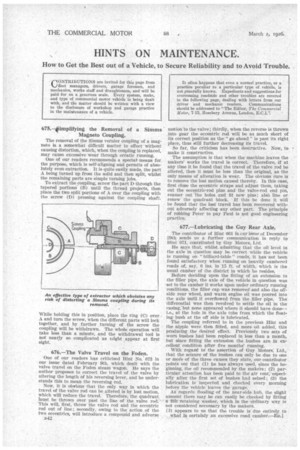HINTS ON MAINTENANCE.
Page 26

If you've noticed an error in this article please click here to report it so we can fix it.
How to Get the Best out of a Vehicle, to Secure Reliability and to Avoid Trouble.
675.—tirnplifying the Removal of a Simms Magneto Coupling.
The removal of the Shnms vernier coupling of a magneto is a somewhat difficult matter to effect without causing distortion, which, when the coupling is replaced, may cause excessive wear through erratic running.
One of our readers recommends a special' means for the purpose, which is self-aligning and permits of absolutely even extraction. It is quite easily made, the part A being turned up from the solid and then split, whilst the remaining parts are simple turning jobs.
To extract the coupling, screw the part Ti through the tapered portions" (13) until the thread projects, then place the two split portions of A over the coupling with the screw (D) pressing against the coupling shaft.
While holding this in position, place the ring (C) over A and turn' the screw, when the different parts will lock together, and by further turning of the screw the coupling will be withdrawn. The whole operation will take less than a minute, and the withdrawal tool is not nearly so complicated as might appear at first sight.
676.—The Valve Travel on the Foden.
Otte of our readers has criticised Hint No. 673 in our issue dated February 9th, which dealt with the valve travel on the Foden steam wagon. He says the author proposes to correct the travel of the valve by altering the length of his reversing lever, and he understands this to mean the reversing rod.
No*, it is obvious that the only way in which the travel of the valve rod can be altered is by lost motion, which will reduce the travel. Therefore, the quadrant tnust be thrown over past the line of the valve rod. This will, first, throw the valve rod and the eccentric rod out of line; secondly, owing to the action of the two eccentrics, will introduce a compound and adverse 342 motion to the valve; thirdly, when the reverse is thrown into gear the eccentric rod will be as much short of its correct position as the "go ahead" is past its right place, thus still further decreasing its travel.
So far, the criticism has been destructive. Now, to make it constructive.
The assumption is that when the machine leaves the makers' works tile travel is correct. Therefore, -if at any time it be found that the travel of the valve rod be altered, then it must be less than the original, as the only means of alteration is wear. The obvious cure is to remove the lost motion caused thereby. In this Case, first close the eccentric straps and adjust them, taking out the eccentric-rod pins and the valve-rod end pin, reamer out the holes and fit new pins; also line or renew the quadrant block. If this be done it will be found that the lost travel has been recovered without adversely affecting any other part. The principle of robbing Peter to pay Paul is not good • engineering practice.
677.—Lubricating the Guy Rear Axle.
The contributor of Hint 661 in cur issue of December 29th sends us a further communication in reply to Hint 671, contributed by Guy Motors, Ltd.
He says that, whilst admitting that the oil level in the axle in question may be correct while the vehicle is running on "billiard-table" roads, it has not been found satisfactory when running on heavily cambered roads of, say, 6 ins. in 15 ft. of width, which is the usual camber of the district in which he resides.
Before deciding upon the fitting of an extension to the filler pipe, the axle of the vehicle in question was set to the camber it works upon under ordinary running conditions, the filler cap was removed. and also the offside rear wheel, and warm engine oil was poured into the axle until it overflowed from the filler pipe. The differential was then revolved to settle the oil in the casing,' but none appeared where it should have done-i.e., at the hole in the axle tube from which the floating bush at the off side is lubricated.
The coupling referred to in the previous Hint and the nipple were then fitted, and more oil added, this producing the desired effect. Previously two sets of worn bushes had been replaced in less than a month, but since fitting the extension the bushes are in excellent condition after five months' running.
With regard to the assertion of Guy Motors, Ltd., that the seizure of the bushes can only be due to one or more of the three causes they state, our contributor points out that (1) he has always used, since the beginning,' the oil recommended by the makers ; (2) particular attention has been paid to the air vent, especially after the first set of bushes had seized ; (3) the lubrication is inspected and checked every morning before the vehicle leaves the garage.
As regards flooding -of the near-side-hub, the slight amount there may be can easily be che?ked by fitting a felt retaining washer, which in the Ordinary way is not considered necessary by the makers.
[It appears to us that the trouble is due entirely. to what is certainly an excessive road camber.—En.]




























